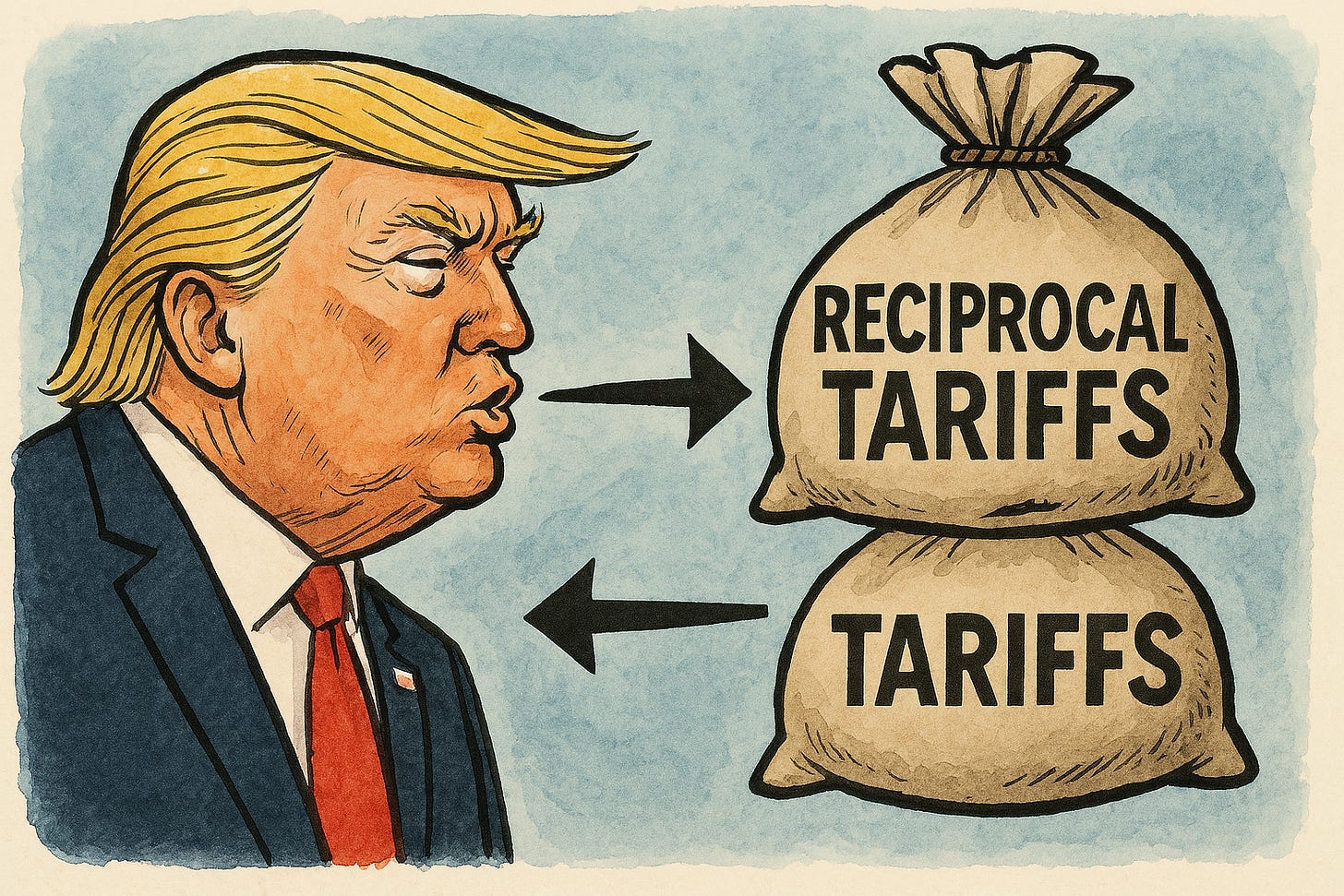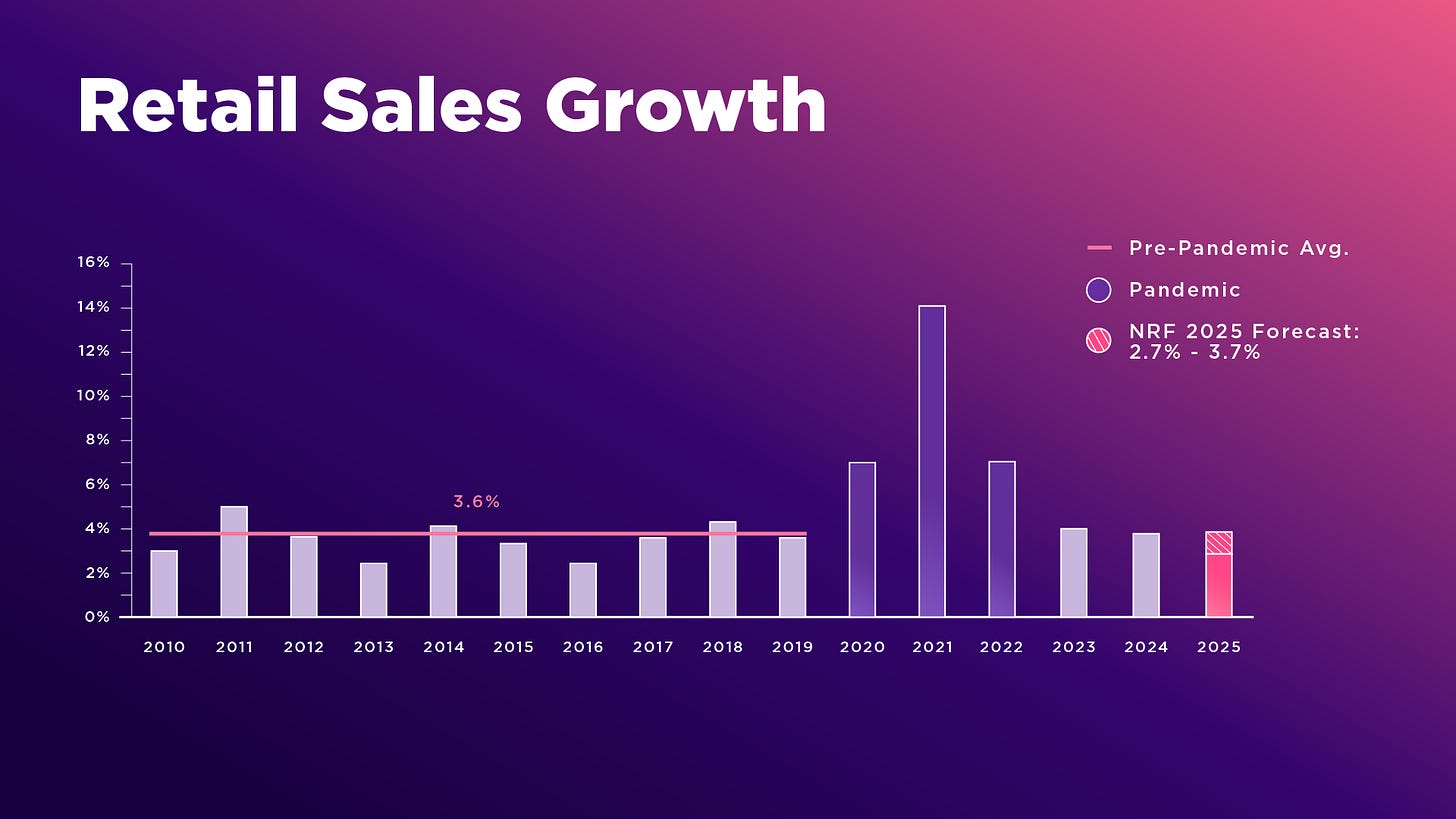Let's Catch Up
NRF's State of Retail and the Consumer, Promat and MWC and some other ramblings
This edition of TWIR is on the house. Enjoy!
Hey Friends,
I feel like there’s a lot we need to catch up on. Most of you have been eagerly following the tariff situation. President Donald Trump signed an aggressive reciprocal tariff policy, setting a 10% baseline tariff on all imports starting April 5. However, "worst offenders"—countries with high tariffs on U.S. goods—face steeper custom tariffs taking effect April 9.
Key tariffs include:
China: 54%
Vietnam: 46%
European Union: 20%
Taiwan: 32%
Japan: 24%
Some countries, including the UK, Singapore, Brazil, and Australia, will only face the 10% baseline tariff. Canada and Mexico are exempt under previous tariffs related to trade and border security.
Additionally, Trump imposed a 25% tariff on all foreign-made automobiles, effective immediately. The move is expected to disrupt global trade, but Trump argues it will protect American jobs and manufacturing.
For more info check out the official statement here……..
Retail investors bought a record $4.7 billion in stocks on Thursday of this week—their biggest single-day buying spree in a decade, according to JPMorgan. They snapped up shares of Nvidia, Amazon, and S&P ETFs, while selling off Tesla. Small-cap tech stocks were especially popular among individual investors, even as institutional investors increased short positions in that sector. The buying came despite the S&P 500 dropping 4.9%, its worst one-day loss since June 2020, following President Trump’s announcement of new import tariffs that stoked recession fears. JPMorgan noted the contrast with retail behavior during the March 2020 COVID selloff and said individual portfolios are down 12.9% year-to-date, underperforming the broader index.
Promat 2025 Recap
I had the pleasure of attending ProMat 2025, held from March 17 to 20 at Chicago's McCormick Place. This is the landmark event in the manufacturing and supply chain space, setting records with 52,223 registered attendees and 1,160 exhibitors across 659,000 net square feet of exhibit space.
Key Themes and Technology Trends:
🔹 Automation and Robotics: The event showcased the latest advancements in automation, including autonomous mobile robots (AMRs) and robotic arms designed to enhance productivity and safety in warehouse operations.
🔹 Artificial Intelligence (AI) and Data Analytics: Discussions emphasized the integration of AI and data analytics in optimizing inventory management, demand forecasting, and decision-making processes. Paul Zikopoulos, VP of Technology Unit Skills & Enablement at IBM, highlighted the critical role of information architects in leveraging AI effectively.
🔹 Sustainability: A significant focus was placed on eco-friendly solutions, such as energy-efficient equipment and sustainable packaging, aiming to minimize environmental impact and promote green practices within the supply chain.
🔹 Supply Chain Resilience: The importance of building resilient supply chains through diversification, risk management, and advanced technologies was a central theme, addressing vulnerabilities exposed by recent global disruptions.
🔹 E-commerce and Last-Mile Delivery: Innovations in last-mile delivery solutions, including smart logistics and drone delivery, were explored to enhance customer experience in the rapidly evolving e-commerce landscape.
Awards and Recognitions:
The 2025 MHI Innovation Awards recognized outstanding achievements:Material Handling Wholesaler
Best New Innovation: Anyware Robotics
Best Innovation of an Existing Product: Concentric, LLC
Best IT Innovation: Fidus Global
Best Innovation in Sustainability: GRI Inc.
Additionally, the MHI StartUp Award was presented to Freespace Robotics, highlighting emerging technologies in the supply chain sector.
What it Means for Retail
There was considerably more retail presence at this years show. ProMat underscored the industry's commitment to embracing technological advancements and fostering resilience in supply chain operations. Retailers are looking for efficiency anywhere they can find it. Fulfillment times are critical and doing more with less was on everyone’s mind. One of the common themes was the adoption of RFID across the supply chain. I would still describe RFID in it’s infancy, but automating the data capture procedure and utilizing natural process flow to capture inventory data is ripe for productivity gains
Mobile World Congress 2025
The Mobile World Congress (MWC) 2025, held in Barcelona from March 3 to 6, was a landmark event in the mobile technology industry, drawing over 109,000 attendees from 205 countries and territories. The conference featured more than 1,200 speakers, with women comprising 41% of the presenters and 27% of the overall attendees.
Key Themes and Session Topics:
Artificial Intelligence (AI) and 5G Integration: A central focus was the transformative impact of AI and 5G on the telecommunications ecosystem. Discussions highlighted AI's role in optimizing network operations, enhancing customer experiences, and preventing fraud. The GSMA’s Mobile Economy Report 2025 noted that 5G connections surpassed two billion by the end of 2024 and are projected to account for 57% of total mobile connections by 2030.
Open Gateway Initiative: The GSMA's Open Gateway initiative was prominently featured, aiming to provide universal access to network capabilities through standardized APIs. This framework seeks to transform telecommunications networks into programmable platforms, fostering collaboration between telcos and developers. A notable announcement was the launch of the Open Gateway Multi-Telco Innovation Lab, a joint effort by MasOrange, Telefónica, Vodafone Group, and the i2CAT research center, to accelerate API standardization and drive cross-industry innovation.
Future Digital Infrastructure: The Smart Networks and Services Joint Undertaking (SNS JU) opened MWC 2025 with a session titled "Digital Infrastructure of the Future: Shaping Europe’s Competitive Edge." This session explored themes such as the shift from transmission-centric to computing-centric digital infrastructures, the strategic importance of digital infrastructure for European technological sovereignty, and the impact of AI and cloud computing on mobile networks.
Innovative Device Launches: MWC 2025 saw several major smartphone manufacturers unveiling new devices. Xiaomi launched its 15 series, featuring the photography-focused 15 Ultra with Leica branding and a 200-megapixel periscope lens. Nothing introduced the 3A series with a triple camera setup. Samsung teased the Galaxy S25 Edge, noted for its ultra-thin design.
Emerging Technologies: The event showcased advancements in foldable devices and unconventional designs. Samsung Display presented a folding gaming device, while Lenovo unveiled multifolding laptops, indicating a trend toward versatile form factors in computing devices.
What it Means for Retail
Retail is moving to a mobile-first environment by enabling mobile commerce, personalized shopping experiences, and seamless transactions through apps and digital wallets. Customer experience and engagement is now being revolutionized by features like AI-driven recommendations, AR/VR try-ons, and social commerce, while also powering location-based marketing and loyalty programs. Mobile tools help retailers optimize inventory, streamline operations, and offer omnichannel options like BOPIS and curbside pickup. Innovations like smart fitting rooms, checkout-free stores, and voice shopping continue to evolve, with 5G and blockchain poised to further enhance speed, security, and customer engagement.
NRF’s State of Retail and the Consumer
“Overall, the economy has shown continued momentum so far in 2025 — bolstered by low unemployment and real wage gains — however, significant policy uncertainty is weighing on consumer and business confidence.”
NRF President and CEO Matthew Shay
The National Retail Federation (NRF) forecasts U.S. retail sales to grow between 2.7% and 3.7% in 2025, reaching $5.42 trillion to $5.48 trillion. This compares to a 3.6% increase in 2024, aligning with the pre-pandemic 10-year average. Non-store and online sales are projected to rise 7%-9% to $1.57-$1.6 trillion, following an 8.1% increase in 2024.
GDP growth is expected to slow to just below 2%, down from 2.8% in 2024. Despite declining consumer confidence due to inflation and tariff concerns, NRF Chief Economist Jack Kleinhenz emphasizes that strong labor markets, steady income growth, and healthy household finances will support consumer spending. NRF anticipates PCE inflation to remain around 2.5%, while consumer credit remains stable with manageable delinquencies.
NRF President and CEO Matthew Shay notes that while economic momentum continues, policy uncertainty affects confidence, but retailers remain focused on serving customers. NRF’s forecast excludes auto dealers, gas stations, and restaurants and is based on economic indicators such as employment, wages, and consumer credit.
A video recap can be seen below
Talk soon. Have a great weekend




